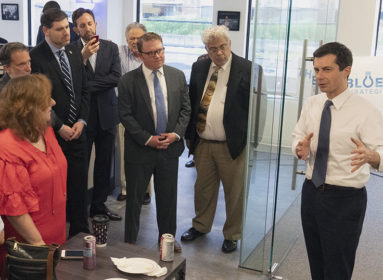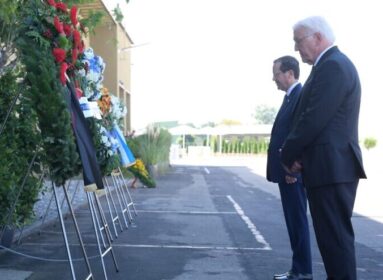 Three Jewish veterans among those to be honored at State Capitol
Three Jewish veterans among those to be honored at State Capitol
Three members of the Greater Hartford Jewish community are among the veterans of the U.S. Armed Forces who will be honored on Thursday, Nov. 8, 1 p.m., when Connecticut celebrates the state’s first Immigrant Veterans Recognition Day at the State Capitol. Those being honored are all immigrants to the U.S. who served in the Armed Forces from World War II through the Iraq and Afghanistan wars. Veterans Recognition Day is co-sponsored by the Office of the Secretary of State, the Jewish Federation Association of Connecticut (JFACT), the Jewish Historical Society of Greater Hartford, the Polish American Foundation, and the Veterans History Project at Central Connecticut State University.
ROMAN LUFTGLAS | Born in 1925 in the Szczakowa district of Poland, Roman Luftglas was deported with his family to Auschwitz when the Nazis invaded in 1939, the last time he would see his parents and brother. After the war, while living in a Displaced Persons camp in the U.S. zone of Germany, Luftglas worked as a mechanic, and then as a film projectionist for the American Jewish Joint Distribution Committee (JDC). He entered ORT, the Jewish education and vocational training organization, training as a welder and sheet-metal mechanic, and worked in an optical firm that manufactured glasses, optical-testing equipment and large-format cameras.
Luftglas met JDC director, Dr. Samuel Haber, who found him a sponsor in Columbia, S.C. Luftglas immigrated there in May 1949, picking up a job as a mechanic at a Chevrolet dealership two days after his arrival.
He was inducted into the U.S. military in 1951, serving as a projectionist first stateside, then in Hokkaido, Japan, before being shipped to Korea with the 45th Infantry as a rifleman and radioman. He was discharged in 1952, invited to Hartford by a friend with whom he had been liberated.
He met his future wife, Goldie, that year, and the couple married the following year and settled in Hartford. He worked as a welder in an electronics shop in Hartford and then as a salesman of photographic equipment for Economy Sales, before opening the Camera Bar in East Hartford in 1956. The Luftglases moved to West Hartford in 1970, where they raised their three daughters.
As a token of respect, the Eastman Kodak Company donated $10,000 in Luftglas’s name to the U.S. Holocaust Memorial Museum.
Retired for 15 years, Luftglas speaks about his wartime experiences in schools and prisons throughout the state, and trains teachers in Holocaust education.
“In retrospect, I am proud to have served in the army for the simple reason that I could somehow repay the U.S. for letting me in and starting a new life,” Luftglas says. “I’m grateful and whatever I did, it was to the best of my ability because I was proud to be part of the Armed Forces.”
DR. FELIX BRONNER | Born in Vienna in 1921, Felix Bronner moved to Berlin in 1929 with his family. In 1937, he joined relatives in Washington, D.C., where he finished high school, then earned an undergraduate degree from the University of California at Berkeley’s Davis campus. His parents narrowly escaped the Nazis and arrived in the U.S. in February 1941 via Portugal.
Bronner wanted to study medical science and entered the U.S. Army in 1942. He trained and served in various positions, from Infantry to medical technician to German-language instructor. He achieved the final rank of Buck Sergeant, discharged in 1946.
He met and married Army Nurse Corps veteran Leah Horowitz in 1947. He earned a PhD in physiology at MIT, working first at the Rockefeller Institute in New York City and then teaching at the University of Louisville Medical School. In 1969, the Bronners moved to Storrs, where Felix joined the faculty of the year-old UConn Health Center, where he is now professor emeritus. They relocated to West Hartford in 1972.
“The ceremony means a lot to me because I came here as a refugee and when I was old enough to enter the army, I was very happy to because I wanted to defeat the Nazis,” Bronner says. “I am privileged to have an opportunity to honor those killed by the Nazis: my relatives, my family, and so many of my people.”
ERNEST GELB | West Hartford resident Ernest Gelb is a native of the Carpathian Ruthenian region of Czechoslovakia (west of Ukraine), where he was born in 1927. The Hungarians occupied the area in 1939. Gelb’s father was deported in 1941 to a forced-labor camp and three years later, Gelb and his mother and three sisters and aunt were rounded up with all other Jewish families and confined to a nearby ghetto. From there, the Jews were taken to Auschwitz, where Gelb’s mother, aunt, and two sisters perished. Gelb was transferred to Buchenwald and two of its sub-camps before landing in a typhoid ward just weeks before liberation. In April 1945, Gelb was transported by wagon to Oranienburg, a concentration camp near Berlin.
Gelb returned to his home town in June 1945, reuniting with his father and one surviving sister. He trained as a machine mechanic. When relatives in New York, some in the jewelry and watchmaking business, agreed to sponsor the family, he learned watchmaking from a friend who was a master watchmaker. The Gelbs immigrated to the U.S. in April 1948 and Ernest settled in Hartford, working for an uncle who managed a jewelry store and attending night school to learn English and to complete his high-school studies.
He was drafted into the U.S. military two months later, but received deferments because of his English-language skills. In 1949, he moved to New York City to manage a watchmaking and jewelry store, and studied Hebrew at night at the Hebrew Teachers’ Institute connected with New York University. When his deferments expired in 1951, Gelb was drafted and sent to Fort Indiantown Gap, Penn., a training ground for replacement troops to be sent to Korea. Because he was not yet a citizen, he was offered the opportunity to refuse to serve, but chose to stay nonetheless. At the end of his training, Gelb was selected to serve in Army Intelligence in Austria, where he spent the next year and was discharged in late 1952.
He returned to Hartford and managed the jewelry department for his uncle in a store in Middletown and met his future wife, Sally, a year later. The couple married in 1957 and settled in Hartford, raising three children and relocating to West Hartford in 1972.
About the Veterans’ Day ceremony at the Capitol, Gelb says, “It means so many things to me, mostly, being grateful and being in a great country where citizens do really matter and that I could bring up my children in Hartford Jewishly.”








 Southern New England Jewish Ledger
Southern New England Jewish Ledger











